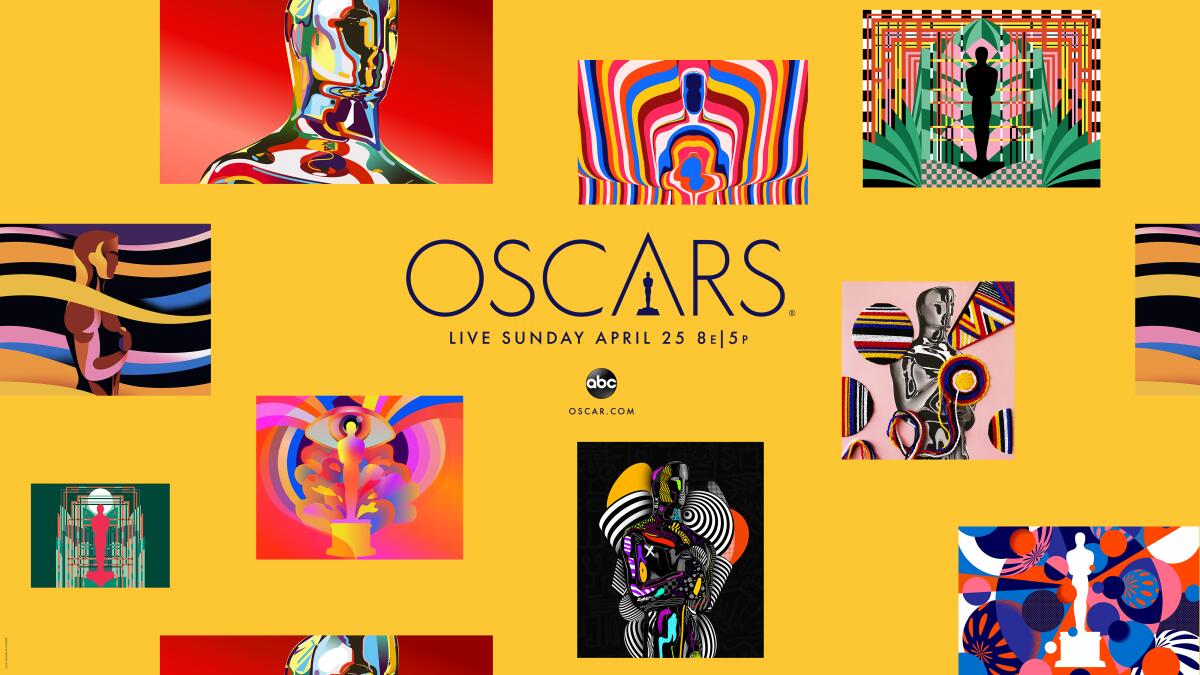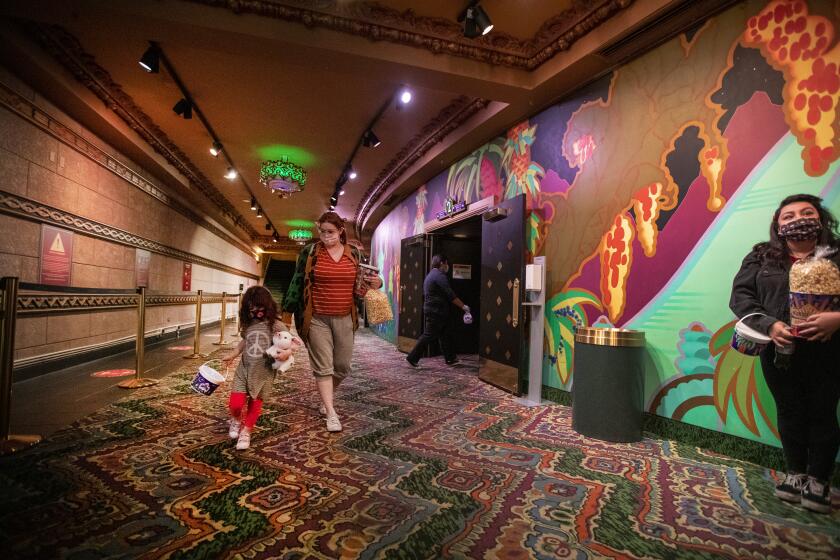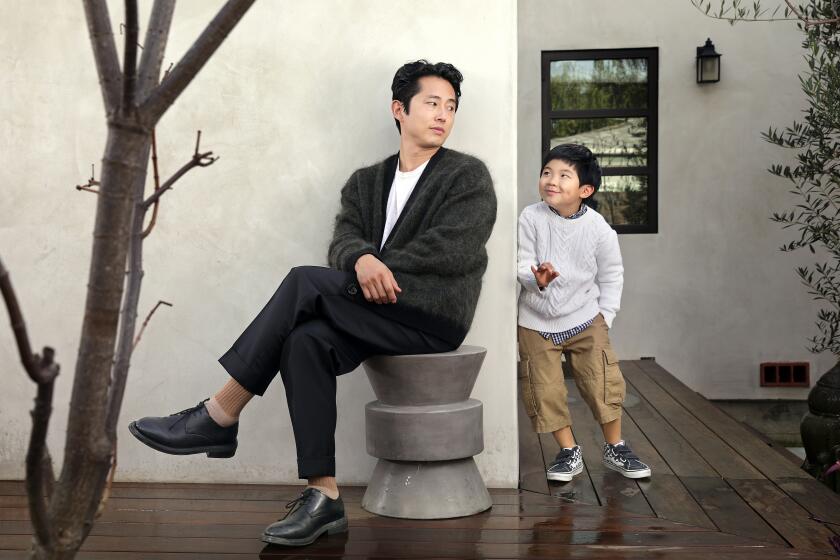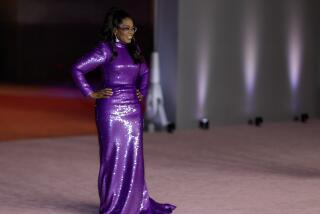The Oscars artwork is as diverse as its noms. Michelle Robinson adds an L.A. flair

After a year in which the COVID-19 pandemic shuttered movie theaters and kept film lovers watching from the isolation of home, Michelle Robinson’s artwork for the upcoming Academy Awards pays glorious tribute to the power of the movie palace.
Robinson was one of seven artists selected to create key art — used in posters and digital promotion — for the 93rd Oscars on April 25. Her “Untitled” piece leans into the Art Deco aspects of her work, fusing Old Hollywood glamour with contemporary flair. It answers “What do movies mean to you?” by portraying a relationship: the golden filament connecting theater and performer.
“There is much to be admired about the stunningly ornate amphitheaters that were built during Hollywood’s golden era of the 1920s and ’30s,” Robinson writes in her artist statement. “It was here, behind towering velvet curtains and beneath elaborately decorated walls and ceilings, that curious minds first began to fall in love with movies.”

The artists, who unveiled their submissions the same weekend that Los Angeles County officials reopened indoor movie theaters at 25% capacity, hail from around the globe: Lagos, Nigeria; Stockholm; Barcelona, Spain; Drammen, Norway; Sydney; Guadalajara; and New York City. Robinson, who is African and Korean American, was born in Seoul, grew into an artist in Los Angeles and now lives in Seattle.
The pandemic is far from over. But for scores of movie-crazed Angelenos, the reopening of multiplexes signals hope is on the way.
This year marks the 30th time the motion picture academy has sought out a designer for the ceremony’s poster, a tradition that began with graphic designer and Oscar-winning filmmaker Saul Bass in 1990. It is only the ninth time the academy has commissioned multiple artists.
Robinson’s piece pays homage to the theaters of yore. Lush greens and bold reds, yellows and pinks convey their splendor around the black silhouette of an Oscar statuette taking center stage.
Whereas artist Temi Coker’s submission speaks directly to Black representation, Robinson’s design carries a more subtle allusion.
“I think subconsciously it was intentional, but also I felt like black is such a color that stood out,” Robinson said. “With the current climate, or the past climate ... people can really resonate with that color. Especially with the Black Lives [Matter] movement. I felt like it could just touch everyone outside who saw it, depending on where their minds were at, where their hearts were at.”
As a woman of color, Robinson said, she felt good witnessing the most diverse slate of actors to be nominated and being part of a campaign that recognizes the talents of underrepresented groups.
Including ‘Minari’ and ‘Nomadland,’ there are multiple projects that scored historic 2021 Oscar nominations. Here’s a helpful guide.
Robinson said she devoted more than three weeks to her piece.
“Once I have an initial idea, I just whip out a blank canvas and I start sketching, lay down the bones,” she said. “When the paint goes down, from that point on, I’m improvising. … With every color that’s laid down, I feel like the piece then transforms and it comes to life.”
Robinson uses acrylics because they’re forgiving: If she doesn’t like something, she can paint over it. She relishes the idea that pieces she sells might have had a couple earlier lives and that the buyers might not realize this.
Robinson sometimes scans her paintings. In the case of the Oscars artwork, she then further transformed it in Photoshop.
“That was work,” she said of the process. “That was tedious. But it was so rewarding to finish.”
Robinson said she can be a maximalist, complicating the decision to declare a work finished. Sometimes she has to stop herself to avoid clutter and crowding.
“Especially with the statuette,” she said. “I could’ve went on for days and days, layering and layering, but I also wanted to make sure that the statute was emphasized. If it’s too busy, then it gets lost.”
Robinson has had a propensity for art since her time at Westlake High School. A neighbor gave her a Picasso book.
“That was the first time I was introduced to Picasso, when I was 15,” she said. “From that point on, I was like, ‘Oh, my God. I think I kind of want to be an artist.’”
Robinson, who has no formal art training, says she purposely doesn’t study other artists, “because I kind of want to be able to create without too many influences..
“Subconsciouses are a crazy thing, and sometimes … maybe my work does look like someone’s work,” she adds. “But it’s not really on purpose.”
Robinson bounces ideas off her twin sister, Marsha Robinson, who also is an artist. Both women spent time at L.A.’s Fashion Institute of Design & Merchandising but ultimately left to pursue art.
“What you can find in both our art is we’re trying to say something. We’re trying to catch your attention,” Marsha said. “And maybe we want to stand out.”
As self-taught artists without access to college art shows, the sisters found it tough to stand out and make their names. Both now have significant social media followings that bolster their online shops.
“Being an artist is not easy. I’m gonna say that right now: It is very, very hard,” Michelle Robinson said. “I think a lot of people romanticize the life of an artist. But it’s tough.”
After showing in L.A. design fairs, farmers markets and flea markets, Michelle found success around 2012 with a clothing line, putting artwork on T-shirts. Now she’s selling art to “Queer Eye” fashion designer Tan France. She also established the MR Visual Arts Award Fund in June for BIPOC women emerging in visual arts.
“There’s a lot of amazing artists of color out there, and I hope that when they see this, and they see that there’s artists who look like them, [they] say: ‘Wow, they were given this opportunity,’” Robinson said of the Oscars artwork. “I hope, if anything, it inspires them to just keep doing what they’re doing, keep sharing their voice artistically, no matter what it is.”
More to Read
The biggest entertainment stories
Get our big stories about Hollywood, film, television, music, arts, culture and more right in your inbox as soon as they publish.
You may occasionally receive promotional content from the Los Angeles Times.









